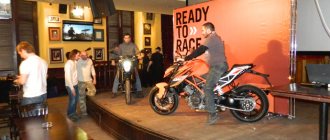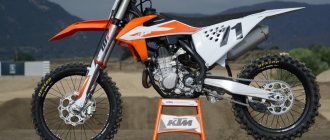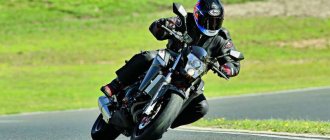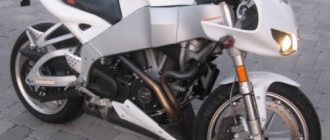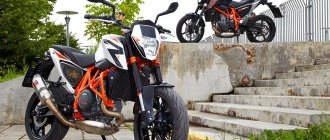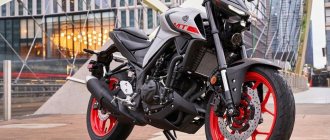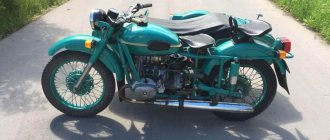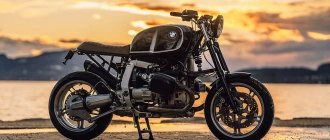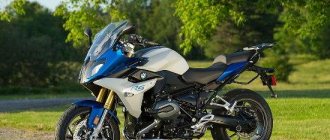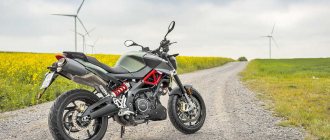Here are photos of the motorcycle under construction.
It so happened that in the fall I became the owner of an IZH Jupiter 4 motorcycle, with a slightly broken mount for everything and a shabby appearance. I decided to do it in my free time, without bothering with the repair period.
I began to clean the entire motorcycle of dirt and used lubricant. I wiped everything outside with rags and a thin brush (using simple kerosene is preferable to poisonous gasoline or diesel fuel with unknown additives). I think it would be more environmentally friendly to wash the outside of the engine with washing powder in some kind of box with water supply and sewerage.
I gradually cleaned all the parts - the front fork tubes with their contents, the rear shock absorbers, the front and rear wheel hubs, the chain. I found normal bolts that were not worn down to half their thickness for attaching the engine to the frame at the front, machined a new bolt for attaching the engine to the frame at the rear, made new bushings for the rear swingarm, found all the bolts, nuts, and spring washers of the required diameters needed for subsequent assembly, and slightly non-standard bolts - such as the one holding the brake pedal - it was once machined a little thicker and the pedal is no longer loose (although the way it is positioned in relation to the pegs is still disgusting).
There were four wheels in my garage - three of them were 18 inches. One - with a chrome rim, slightly shabby spokes, a neat aluminum hub of the wheel itself, but with bad, worn splines - as if sometime when changing wheels, dirt got on these splines, and the wheel was installed without wiping off the grease and dirt. The second wheel had a slightly shabby painted rim, another one had peeling sharp flaps of chrome plating and spokes that looked very rusty. And another 19-inch wheel with 3.25-inch wide tires. Replaced bearings in all wheels. Eight bearings costing 60 rubles each required 480 rubles from me. I improved the appearance of all the wheels, except for the 19-inch one, which I later installed on Jupiter 5, which I was repairing at the time for a friend.
Photo of Jupiter 5 from a friend:
Here is a bicycle tube that protects the front fork guides. It is very labor-intensive to pull a 1.90-2.10-inch camera onto Jupiter pipes with a diameter of 33 mm. There are tubes for wider bicycle tires, but it’s probably better to use them.
I cleaned the wheel spokes by hand with strips of sandpaper. I cleaned the rims with a homemade attachment for a drill or grinder - a bolt or pin sawn through the threaded end, into which a not too long strip of sandpaper is inserted (width 15-20 mm, length - 8-12 centimeters) - a long one will whip your fingers too hard, and even and will greatly heat the motor of low-power (125 W like mine from Skil) sanders.
I cleaned the wheel hubs with an abrasive rubber grinder attachment (hard green rubber - as if it had GOI paste - on a metal rod). The attachments cost 15 rubles apiece, for a 2 mm collet (such a collet was included with the Skil sander), it’s better not to take the shaped ones at all (they are attached to the tip of the rod, they work a little and no longer stick to the rod), but buy them made in the shape of the letter T, but you can’t crawl with them everywhere, but when they wear out, they don’t fall apart like figured nozzles, and they can go through all the places with a small radius of passage.
It’s probably better to make round pieces from a sheet of finely abrasive Scotch-Brite and attach them with a bolt to one of the attachments that comes with the sander.
How did the motorcycle turn out the way it is?
The metal is sanded and coated with clear acrylic varnish. Selected color combinations and everything glossy are still boring from fiddling with computer programs. I wanted something like the so-called post-apocalyptic industrial theme. Here, for example, from the Detroit Bros workshop:
In general, I decided to assemble the Jupiter without the side borders and so that it would all shine with the steel from which it is made.
I bought a kilogram package of car varnish, it turned out to be acrylic, from Vika (about 500 rubles). I also bought thinner for acrylic paints and varnishes, also from Vika (a couple of jars for 90 rubles each), but later the hardener ran out faster than the thinner (a small jar of hardener was included with a jar of varnish). It seems that the domestic solvent R-12 is friendly with any acrylic paints and varnishes, but I have not checked.
I planned to paint with a purchased touch-up airbrush from MATRIX - with a simple round nozzle, a 0.2-liter aluminum tank, designed specifically for regular paint (not for all sorts of filling primers, which require a large diameter nozzle, greater pressure and, accordingly, greater air flow), produces spot from 5 mm to 4-5 centimeters, economically consumes paint.
I bought this touch-up airbrush for 690 rubles. And for 200 rubles a filter drier is small for him, for another 50 rubles for a set of two flanges (for a thin oxygen hose) and two nuts for a bayonet connection of such a flange to the airbrush.
On occasion, I got the compressor quite inexpensively, homemade, from a compressor from a refrigerator, a small receiver, a pressure gauge on the receiver itself, and an oxygen reducer with a thin oxygen hose. I've already modified it a little:
And also modified:
Steampunk compressor:
Such a compressor will not handle spray guns with high air consumption, but my touch-up airbrush works, and a small airbrush will work even more so. Although you can try a small spray gun with an LVLP spray system (originally made to work at low pressure and air flow) from IWATA, for example (I saw it on the Internet for 2300 rubles). But the compressor works no louder than a refrigerator. Otherwise, I would buy a compressor from my next salary (this is approximately 5,000 - 7,000 rubles).
Cross Izh
I would like to point out right off the bat that there are no serial bikes with such an official name and never have existed. For some motorcycle enthusiasts, this term serves as another name for the legendary Izh Planet Sport. Others carry out sports tuning of a bike from the Izhevsk Motor Plant, which is later called Izh Pod Cross or Izh Planet Cross. Let us also note that Jupiters are also amenable to such modernization in domestic practice. All types of light and medium bikes are suitable for amateur cross-country reformation. And since the above-mentioned Russian motorcycles are among the most powerful in these classes, they are often taken as a base for further modernization and tuning.
Izh Cross, which can be bought today in many cities and villages (since there are many mechanical enthusiasts in our homeland). In this case, you will not have to study a sea of information regarding the features of the structural alteration of the iron horse. However, such a decision will slightly deplete your family budget.
How I decided to remove paint
It was necessary to have some kind of more or less durable grinder with an attachment made of Scotch Brite of suitable grain size, with Velcro on a cup with a rubber base. The surface would immediately be obtained without unnecessary scratches (although traces of metal molding and roughly cleaned welds previously hidden under paint would be visible).
Here, for example, are traces of metal molding:
Plus, the welds would have to be cleaned with a brush made of thin steel wires - also an angle grinder or a light high-speed reversible drill with such an attachment.
But instead of a so-so drill (and this is my drill in the photo and screws screws) with the money I had, I bought a semi-professional Skil grinder with a flexible shaft for 1390 rubles (790 rubles in the configuration without a flexible shaft; the flexible shaft resembles a speedometer cable in braid), I didn’t really use a single attachment from it. I asked him to sharpen an M6 bolt for a 3.2 mm collet, sawed it at the end and put small strips of sandpaper there.
This device made it possible to remove paint from the wheel rim without disassembling the wheel (without separating the rim and the wheel hub).
By the way, never clamp Chinese 3.0 mm bits with such a collet - they will turn and you will have to buy a whole set of collets (they are for different drills) in a radio parts store, which costs 200 rubles. Probably, the collet is 3.00 mm and not 3.20 mm and you need to clamp such attachments.
Included with the grinder was a pencil-shaped attachment made of diamond-coated steel. She was able to trim welds and draw on glass jars (the part with the largest diameter). These are sold in separate sets, but it’s still a shame to trim the metal with them.
You have to add machine oil to the flexible shaft of the grinder - in the place where it connects to the grinder, it then leaks out and ends up everywhere - on the floor, mask, face and clothes. It is better not to set the speed above positions 3, 4 or 5 during different operations set by the speed controller (there are 6 positions in total), since the motor in it starts to heat up too quickly at high speeds, the smell of insulation appears and you feel sorry for the sander.
Almost all the paint and rust was removed from the motorcycle with this sander. A grinder in addition to a grinder like this would be much faster, perhaps two or three days for all the parts including the frame. Some parts were cleaned by hand. It’s more pleasant to work by hand; there’s no rush like with a power tool. I would have done exactly this without a sander.
The best thing is a durable air compressor with sufficient liters per minute and air pressure capacity, and a few tools to go with it (a durable straight sander with easily replaceable bearings and a small angle sander with a rubber backing for Velcro). The rotation of the attachments in such tools simply stops and they do not get knocked out of your hands like a power tool - which often has a kilowatt of power to withstand possible overheating from prolonged use.
ZiGG › Blog › Infectious two wheels 3. From classic to enduro at the price of a frame.
Hello, dear reader!
I am writing on the occasion of the completion of new modernizations. As they say to me, passing by the process of innovation: “A bad head does not give rest to the hands” or “The dog has nothing to do - he... licks” - as if hinting. But these are people who are not knowledgeable and do not strive for growth.
More and more local creative people are lured by photographs of half-naked ladies in front of their chariots, sometimes unremarkable ones. But your faithful servant will again try to surprise you with rusty, overcooked iron and garage engineering.
First, I’ll try to explain what kind of enduro it is and what “Yzh Plonita 5” has to do with it.
— classic bike
. It's like a regular B/C class sedan. Like Lada in the world of motorcycles. Classics (not just Izhi, but as a class as a whole) are distinguished by an upright landing, more or less high ground clearance, a suspension that compromises in handling/stiffness/energy consumption and a low- or mid-range engine. As you probably already guessed, this is something in between everything, for comfortable movement on many types of surfaces.
Enduro motorcycles are relatives of motocross motorcycles. Close in appearance and distant in filling.
- These are two-wheeled SUVs. They are divided into several more categories (soft, hard, tour), but the common features are: a motor with a wide torque range, energy-intensive suspensions (softer, with longer strokes), high ground clearance, exhaust from above and, of course, tires. These comrades talk about enduro in more detail and interestingly:
Why not just take a foreign car then? Why not a finished, tested and evenly welded product? Because 250 - 300 cc pepelats equivalent in power, even at a fairly advanced age, bite well. At a price. This is a sure 100k and above. On the one hand, it’s inexpensive, but on the other... Let’s just say it’s not for everyone, especially when the financial flow flows very well into four-wheeled projects. But I’d like to have enough for two, for a change!
“Sovietcycles”, “our vulgar self-pumpers” and whatever they call them come to the rescue... After all, for modest money they can give a lot of pleasure to a novice rider, and with some modifications - even more.
The best donors for this cause are the Planets. Especially 5 and PS. So to speak, top versions of single-cylinder Izhas. Quite unpretentious, high-torque and, I would even say, reliable. The engine cranks up to 5-6 thousand for the P5 and even up to 7 for the PS, with modifications to the ignition. If you have a Ural/Dnieper, don’t damage your motorcycle! It is long-wheelbase, too heavy, prone to overheating with a highly inert cardan drive. In general, there will be less pleasure in the end. Minsk, sunrise, owl - light, compact and also suitable. But less powerful and with their own problems (many people know for sunrise boxes, etc.) Jupiter is more capricious and less reliable. IMHO - Izh Planet is the best choice.
Made in USSR + Japan
It is interesting that all the main components and assemblies were domestic (except perhaps for the Japanese carburetor), that is, our own technologies made it possible to implement any modern designs - and to do this in mass production and with the expectation of long-term operation. Which, in fact, is not surprising, because IzhMash at that time was a defense complex enterprise. Only minor components of IZH PS were purchased abroad - lighting equipment and electrical appliances.
The Avtoexport advertising poster shows an experimental motorcycle; it was distinguished by its engine and cladding parts.
Imported parts provided the new product with a marketable appearance: style, design, neatness of finishing - what we really had problems with. According to the recollections of IzhMash veterans, in the first year of production (1973 - 1974) 30 thousand sets of 12 units of components each were purchased from Japan.
In the second year, by the way, the Japanese raised the price 2.5 times, purchased spare parts again, but in the end this played a role and the later PeEs lost imported parts, losing not only the “foreign” finish, but also 4 liters. With. power.
Adjusting the carburetor of the IZH Jupiter motorcycle
Setting up Peker carburetors on the IZH Jupiter 5 motorcycle is carried out as follows. First, we check the tightness and integrity of the air filter. Then we check the serviceability of the ignition. After this, we proceed to adjustment, the algorithm is as follows:
A few words about setting up the Jikov-2928CE carburetor. The idle speed setting here is similar to that of the K-65. The only differences are in the location of the adjusting screws. In Jikov they are conveniently located on the side of the carburetor (the one that is screwed in at an angle is responsible for the height of the throttle valve).
Latest changes in the history of Izh Planet Sport
1979 brought some, not the best, changes to the creation of motorcycles. Manufacturers sought to completely get rid of foreign parts and components that were of higher quality than domestically produced parts. The price of motorcycle spare parts has been reduced accordingly.
Already in April 1975, based on the so popular and beloved by people, Planet Sports, production of new models was launched:
- sports Izh M-15
- cross Izh-K-15
“Dog” - this is the nickname that Soviet motorcyclists awarded Planet Sport. It was popular and in demand for many years, due to which it was repeatedly subjected to engine tuning. The Dog cylinder was, as a rule, sharpened to fit a CheZet or M-412 Moskvich piston.
This was the way the Planet Sport 500 was born. It can be called a truly great work of art by Soviet tuning artists.
Conclusion
In the modern world, restoration of retro motorcycles remains the preserve of enthusiasts who are willing to spend not only a lot of time, but also a lot of money on their favorite hobby. If you are one of them, then Izh PS can take its place in your garage. But there is no point in buying it specifically for driving, unless you are a fan of retro technology.
Specifications
| Power: | 32 l. With. at 6700 rpm min HP |
| Engine type (cylinder arrangement): | single-cylinder, two-stroke, with three channels and five purge windows |
| Number of cylinders: | 1 |
| Engine capacity: | 340 cm3 |
| Cooling type: | Air |
| Transmission: | Mechanical 4-speed |
| Drive unit: | Chain |
| Frame: | Steel |
| Weight: | 135 kg |
| Tank capacity: | 14 l. |
| Maximum speed: | 140 km/h |
| Wheelbase: | 1390 mm |
Planet 3 tuning
Of course, many owners of IZH Planet 3 tune their motorcycle. But not everything that you want is useful. For example, boosting the engine leads to rapid wear and tear of the unit and inevitable repairs, since it is simply not designed for such power. But converting the power supply system from contact to non-contact, strengthening the frame, installing a sliding contact with the corresponding board are completely compatible with this technique. Although modern owners do not think twice, since IZH Planet 3 today is sometimes available for free. They boldly experiment. But the rare and reliable motorcycle still lives a full life. And it is in great demand among fans of metal motorcycles.
Tuning Izh Planet 5. Preparation.
If you bought an expensive Japanese motorcycle, tuning it will become difficult, and you won’t be able to carry out the upgrade yourself. Do-it-yourself tuning of Izh Planet 5 is quite simple, you will only need to have a small set of equipment and from an old Soviet transport you will get a modern and powerful motorcycle. Any tuning consists of two types - external and internal (change in technical characteristics). Let's look first at the first option, namely modernizing the appearance.
Motorcycle Izh Planet Sport: characteristics and photos
Back in 1987, the Izhevsk plant produced the legend of Soviet motorcycle technology - the IZH Planet 5 motorcycle. To this day, this model is in good demand; since then, hundreds of thousands of Izhovs have been sold.
The characteristics of the motorcycle are so good that from the moment of purchase the vehicle could be used both on rural roads and in the city, as evidenced by the powerful engine and modern design. Even with modern technology, Izh can compete and even win in some parameters. With an engine of only 1 cylinder, the motorcycle is capable of producing a considerable 22 horsepower. Fuel consumption at an average speed of 90 km/h is 5 liters. As for the factory maximum, the characteristics of Izh Planet 5 allow it to reach a speed of up to 120 km per hour. Thanks to its reliable design and high-quality Soviet assembly, the transport is unpretentious and easy to maintain after difficult operation.

